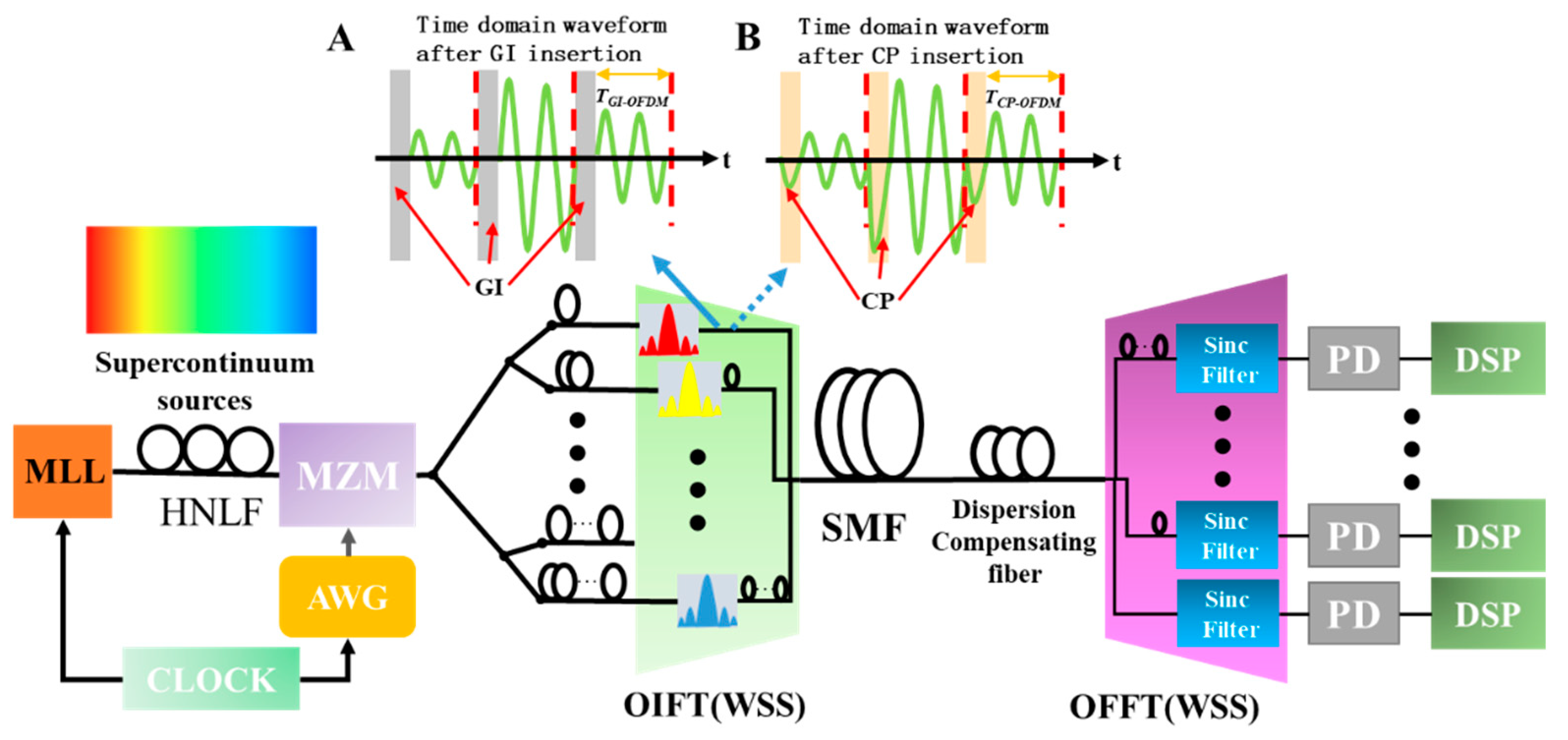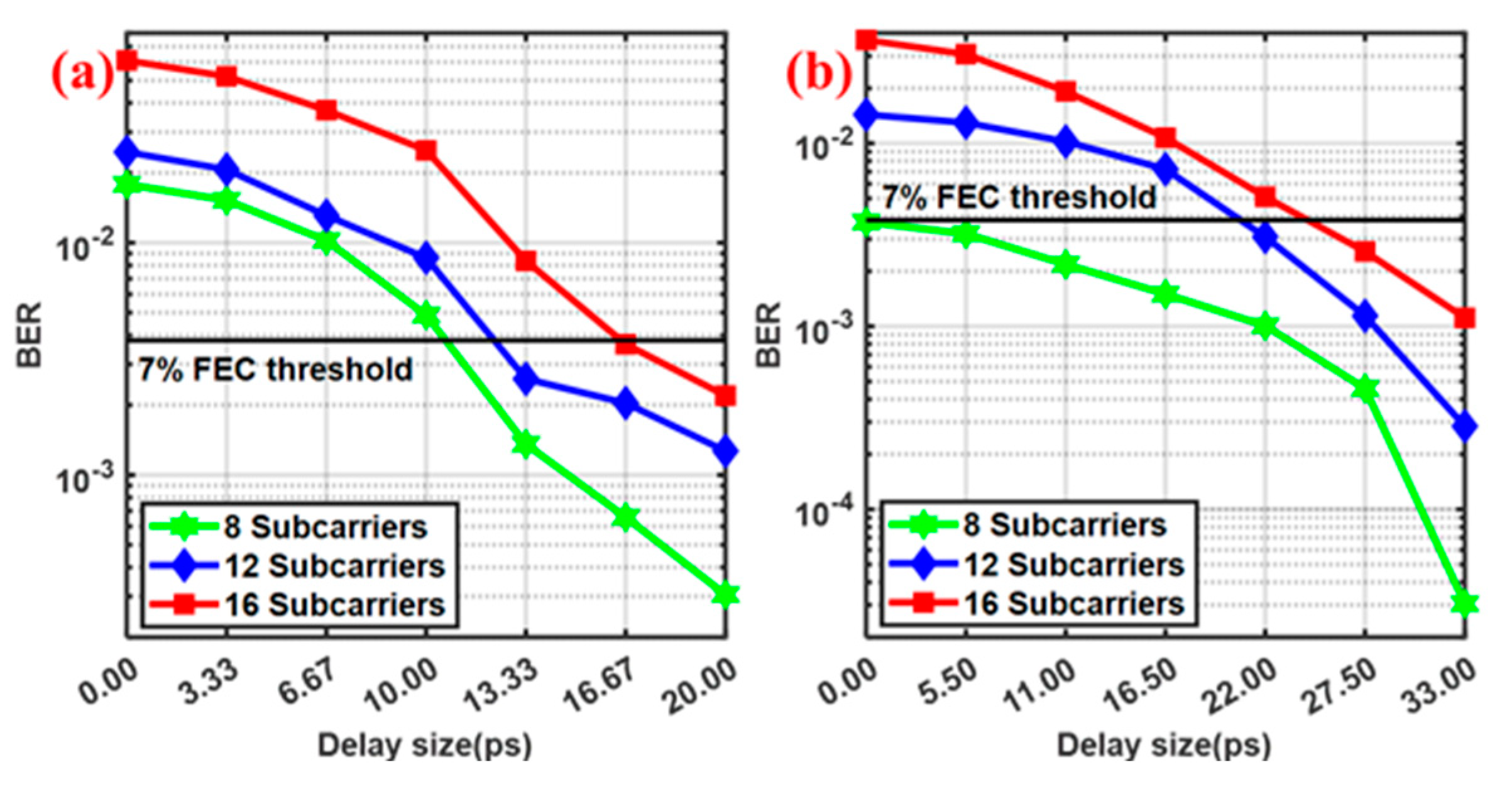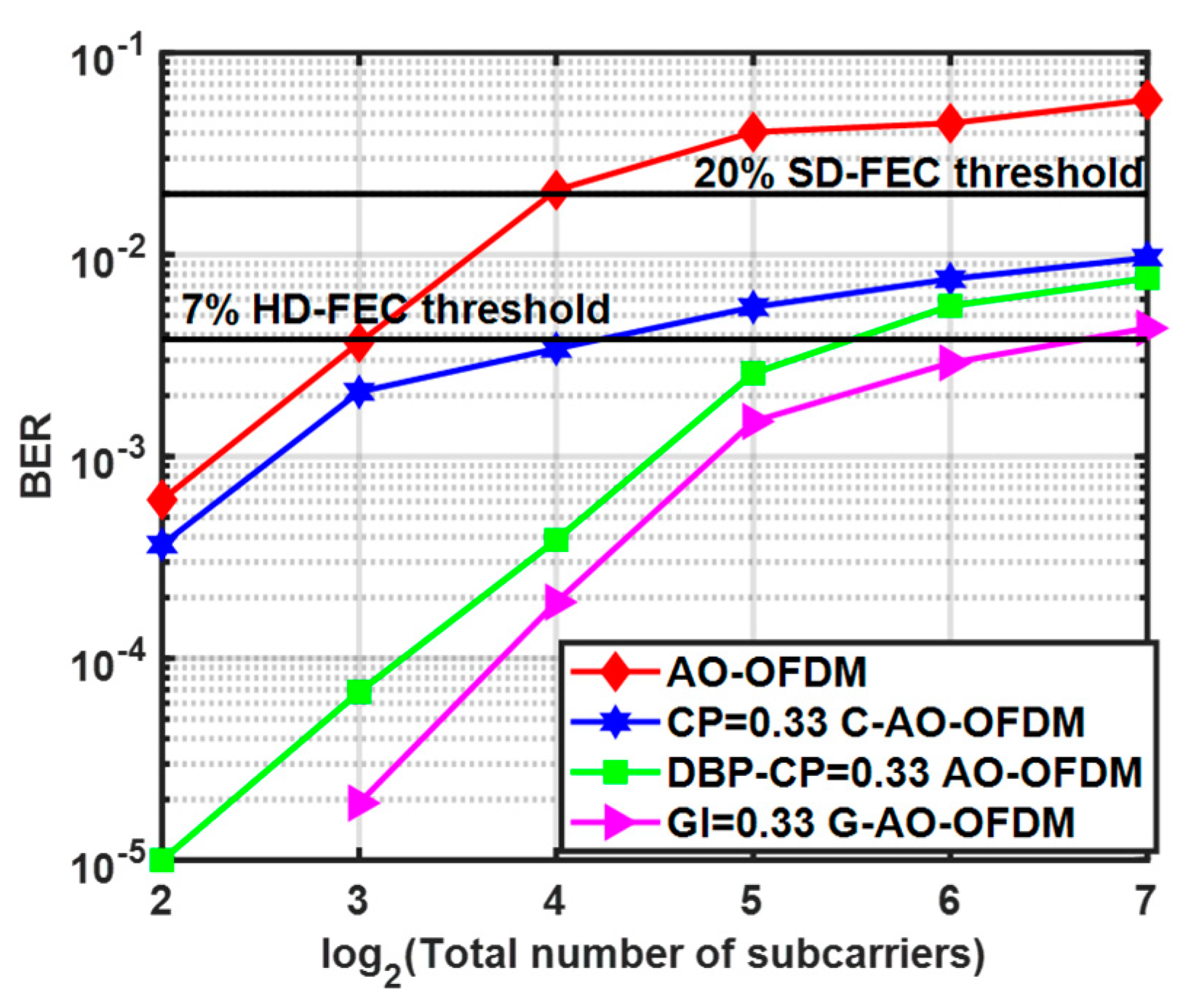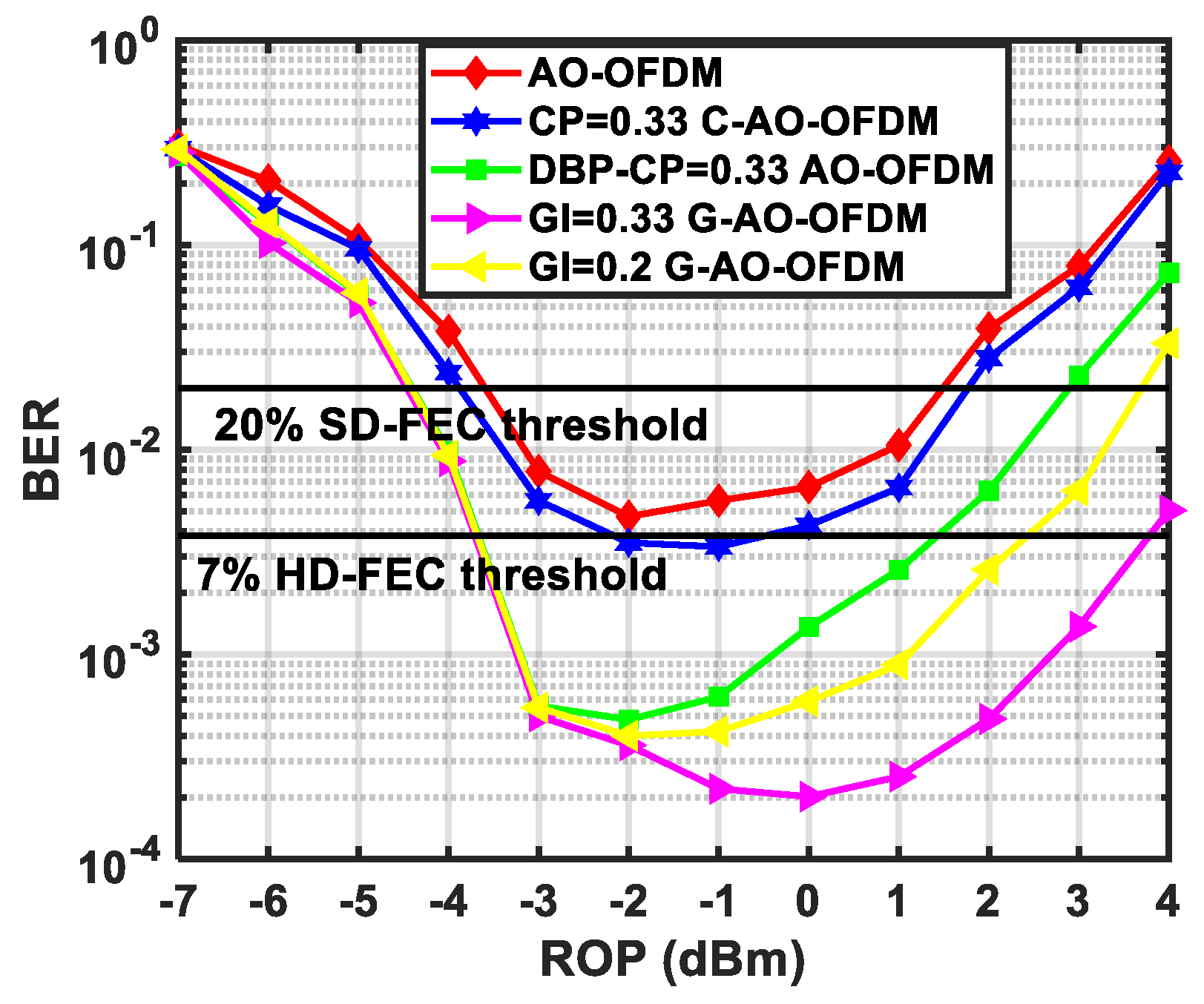Improving the Resistance of AO-OFDM Signal to Fiber Four-Wave Mixing Effect Based on Insertion Guard Interval
Abstract
1. Introduction
2. Principle
2.1. The AO-OFDM System Inserted GI
2.2. The FWM Products in AO-OFDM Systems
2.3. Use GI to Improve the Anti-FWM Effect Ability of AO-OFDM System
3. Simulation and Results
3.1. Effect of Delay on Anti-FWM Effect of AO-OFDM Signal after GI Insertion
3.2. Comparison of Multiple FWM Effect Suppression Methods under Different Transmission Conditions
4. Future Works
5. Conclusions
Author Contributions
Funding
Institutional Review Board Statement
Informed Consent Statement
Data Availability Statement
Conflicts of Interest
References
- William, S.; Bao, H.; Tang, Y. Coherent optical OFDM: Theory and design. Opt. Express 2008, 16, 841–859. [Google Scholar]
- Konstantinos, C.; Tomkos, I.; Varvarigos, E. Elastic bandwidth allocation in flexible OFDM-based optical networks. J. Lightw. Technol. 2011, 29, 1354–1366. [Google Scholar]
- Moreolo, M.; Fabrega, J.; Nadal, L.; Vílchez, F.; Mayoral, A.; Vilalta, R.; Muñoz, R.; Casellas, R.; Martínez, R.; Nishihara, M.; et al. SDN-enabled sliceable BVT based on multicarrier technology for multiflow rate/distance and grid adaptation. J. Lightw. Technol. 2016, 34, 1516–1522. [Google Scholar] [CrossRef]
- Lowery, A.J.; Du, L. All-optical OFDM transmitter design using AWGRs and low-bandwidth modulators. Opt. Express 2011, 19, 15696–15704. [Google Scholar] [CrossRef] [PubMed]
- Wang, Z.; Kravtsov, K.S.; Huang, Y.; Prucnal, P.R. Optical FFT/IFFT circuit realization using arrayed waveguide gratings and the applications in all-optical OFDM system. Opt. Express 2011, 19, 4501–4512. [Google Scholar] [CrossRef]
- Lowery, A.J. Inserting a cyclic prefix using arrayed-waveguide grating routers in all-optical OFDM transmitters. Opt. Express 2012, 20, 9742–9754. [Google Scholar] [CrossRef]
- Shimizu, S.; Cincotti, G.; Wada, N. Demonstration and performance investigation of all-optical OFDM systems based on arrayed waveguide gratings. Opt. Express 2012, 20, B525–B534. [Google Scholar] [CrossRef]
- Kodama, T.; Miyazaki, T.; Hanawa, M.; Maruta, A.; Wada, N.; Cincotti, G. Low-speed DSP assisted dispersion compensation-free IM/DD optical OFDM transmission over 100 km-SMF using time-and frequency-domain sparse-subcarrier multiplexing. In Proceedings of the 2019 Optical Fiber Communications Conference and Exhibition (OFC), San Diego, CA, USA, 3–7 March 2019; pp. 1–3. [Google Scholar]
- Hillerkuss, D.; Schmogrow, R.; Schellinger, T.; Jordan, M.; Winter, M.; Huber, G.; Vallaitis, T.; Bonk, R.; Kleinow, P.; Frey, F.; et al. 26 Tbit s−1 line-rate super-channel transmission utilizing all-optical fast Fourier transform processing. Nat. Photon. 2011, 5, 364–371. [Google Scholar] [CrossRef]
- Schröder, J.; Du, L.; Carpenter, J.; Eggleton, B.; Lowery, A. All-optical OFDM with cyclic prefix insertion using flexible wavelength selective switch optical processing. J. Lightw. Technol. 2013, 32, 752–759. [Google Scholar] [CrossRef]
- Lowery, A.J.; Schröder, J.; Du, L.B. Flexible all-optical frequency allocation of OFDM subcarriers. Opt. Express 2014, 22, 1045–1057. [Google Scholar] [CrossRef]
- Hmood, J.; Harun, S. PAPR reduction in all-optical OFDM based on time interleaving odd and even subcarriers. Opt. Commun. 2019, 437, 237–245. [Google Scholar] [CrossRef]
- Song, B.; Zhu, C.; Corcoran, B.; Zhang, L.; Lowery, A.J. Banded all-optical OFDM super-channels with low-bandwidth receivers. Opt. Express 2016, 24, 17968–17979. [Google Scholar] [CrossRef] [PubMed]
- Lowery, A.J.; Wang, S.; Premaratne, M. Calculation of power limit due to fiber nonlinearity in optical OFDM systems. Opt. Express 2007, 15, 13282–13287. [Google Scholar] [CrossRef]
- Yu, C.; Liu, B.; Chen, G.; Gao, Y.; Sheng, X.; Wang, X.; Xu, X.; Xin, X. Nonlinear effect on sinc-shaped optical filter demultiplexing all-optical OFDM system. Opt. Commun. 2020, 458, 124872. [Google Scholar] [CrossRef]
- Nazarathy, M.; Khurgin, J.; Weidenfeld, R.; Meiman, Y.; Cho, P.; Noe, R.; Shpantzer, I.; Karagodsky, V. Phased-array cancellation of nonlinear FWM in coherent OFDM dispersive multi-span links. Opt. Express 2008, 16, 15777–15810. [Google Scholar] [CrossRef]
- Chen, G.; Tian, Q.; Zhang, X. Study on the reconfiguration and switching of subcarriers in all-optical orthogonal frequency division multiplexing system. Microw. Opt. Technol. Lett. 2021, 63, 1571–1575. [Google Scholar]
- Wang, C.; Tian, F.; Wang, Y.; Zhang, Q.; Tian, Q.; Gao, R.; Wang, X.; Pan, X.; Yang, L.; Xin, X. Digital back propagation based on the feedback-convergence for fiber nonlinearity compensation with low computational complexity and high performance. Opt. Commun. 2020, 471, 126050. [Google Scholar] [CrossRef]
- Gonçalves, J.; Martins, C.S.; Guiomar, F.P.; Cunha, T.R.; Pedro, J.C.; Pinto, A.N.; Lavrador, P.M. Nonlinear compensation with DBP aided by a memory polynomial. Opt. Express 2016, 24, 30309–30316. [Google Scholar] [CrossRef]
- Martins, C.S.; Bertignono, L.; Nespola, A.; Carena, A.; Guiomar, F.P.; Pinto, A.N. Low-Complexity Time-Domain DBP Based on Random Step-Size and Partitioned Quantization. J. Lightwave Technol. 2018, 36, 2888–2895. [Google Scholar] [CrossRef]
- Gagni, M.; Guiomar, F.P.; Wabnitz, S.; Pinto, A.N. Simplified high-order Volterra series transfer function for optical transmission links. Opt. Express 2017, 25, 2446–2459. [Google Scholar] [CrossRef]
- Guiomar, F.P.; Pinto, A.N. Simplified Volterra series nonlinear equalizer for polarization-multiplexed coherent optical systems. J. Lightw. Technol. 2013, 31, 3879–3891. [Google Scholar] [CrossRef]
- Gou, P.Q.; Yu, J.J. A nonlinear ANN equalizer with mini-batch gradient descent in 40Gbaud PAM-8 IM/DD system. Opt. Fiber Technol. 2018, 46, 113–117. [Google Scholar] [CrossRef]
- Bitachon, B.I.; Ghazisaeidi, A.; Baeuerle, B.; Eppenberger, M.; Leuthold, J. Deep Learning Based Digital Back Propagation with Polarization State Rotation & Phase Noise Invariance. In Proceedings of the Optical Fiber Communication Conference (OFC), San Diego, CA, USA, 8–12 March 2020; p. 2. [Google Scholar]







| Parameters | Values | Parameters | Values |
|---|---|---|---|
| Subcarrier symbol rate | 10 GBaud | Clock frequency | 10 GHz |
| MLL center frequency | 193.1 THz | Sinc-shaped Filter bandwidth | 10 GHz |
| DF-HNLF Dispersion | 0.31 ps/nm/km | Sample pre–symbol | 128 |
| DF-HNLF Nonlinear coefficients | 11.7/W/km | ADC resolution | 8 bit |
| PD thermal noise | 10 pA/Hz0.5 | PD responsivity | 1 A/W |
| MZM VpiDC | 3 | MZM VpiRF | 3 |
| SMF Dispersion | 17 ps/nm/km | DCF Dispersion | −170 ps/nm/km |
| SMF Dispersion slope | 0.08 ps/nm2/km | DCF Dispersion slope | 0.02 ps/nm2/km |
| SMF Cora area | 80 μm2 | DCF Cora area | 80 μm2 |
| SMF Nonlinear index | 2.6 × 10−20 | DCF Nonlinear index | 4.6 × 10−20 |
| SMF Attenuation coefficient | 0.2 dB/km | DCF Attenuation coefficient | 0.4 dB/km |
Disclaimer/Publisher’s Note: The statements, opinions and data contained in all publications are solely those of the individual author(s) and contributor(s) and not of MDPI and/or the editor(s). MDPI and/or the editor(s) disclaim responsibility for any injury to people or property resulting from any ideas, methods, instructions or products referred to in the content. |
© 2023 by the authors. Licensee MDPI, Basel, Switzerland. This article is an open access article distributed under the terms and conditions of the Creative Commons Attribution (CC BY) license (https://creativecommons.org/licenses/by/4.0/).
Share and Cite
Lv, K.; Liu, H.; Zhang, A.; Feng, L.; Sheng, X.; Liu, Y.; Li, J.; Huo, X. Improving the Resistance of AO-OFDM Signal to Fiber Four-Wave Mixing Effect Based on Insertion Guard Interval. Photonics 2023, 10, 311. https://doi.org/10.3390/photonics10030311
Lv K, Liu H, Zhang A, Feng L, Sheng X, Liu Y, Li J, Huo X. Improving the Resistance of AO-OFDM Signal to Fiber Four-Wave Mixing Effect Based on Insertion Guard Interval. Photonics. 2023; 10(3):311. https://doi.org/10.3390/photonics10030311
Chicago/Turabian StyleLv, Kai, Hao Liu, Anxu Zhang, Lipeng Feng, Xia Sheng, Yuyang Liu, Junjie Li, and Xiaoli Huo. 2023. "Improving the Resistance of AO-OFDM Signal to Fiber Four-Wave Mixing Effect Based on Insertion Guard Interval" Photonics 10, no. 3: 311. https://doi.org/10.3390/photonics10030311
APA StyleLv, K., Liu, H., Zhang, A., Feng, L., Sheng, X., Liu, Y., Li, J., & Huo, X. (2023). Improving the Resistance of AO-OFDM Signal to Fiber Four-Wave Mixing Effect Based on Insertion Guard Interval. Photonics, 10(3), 311. https://doi.org/10.3390/photonics10030311




